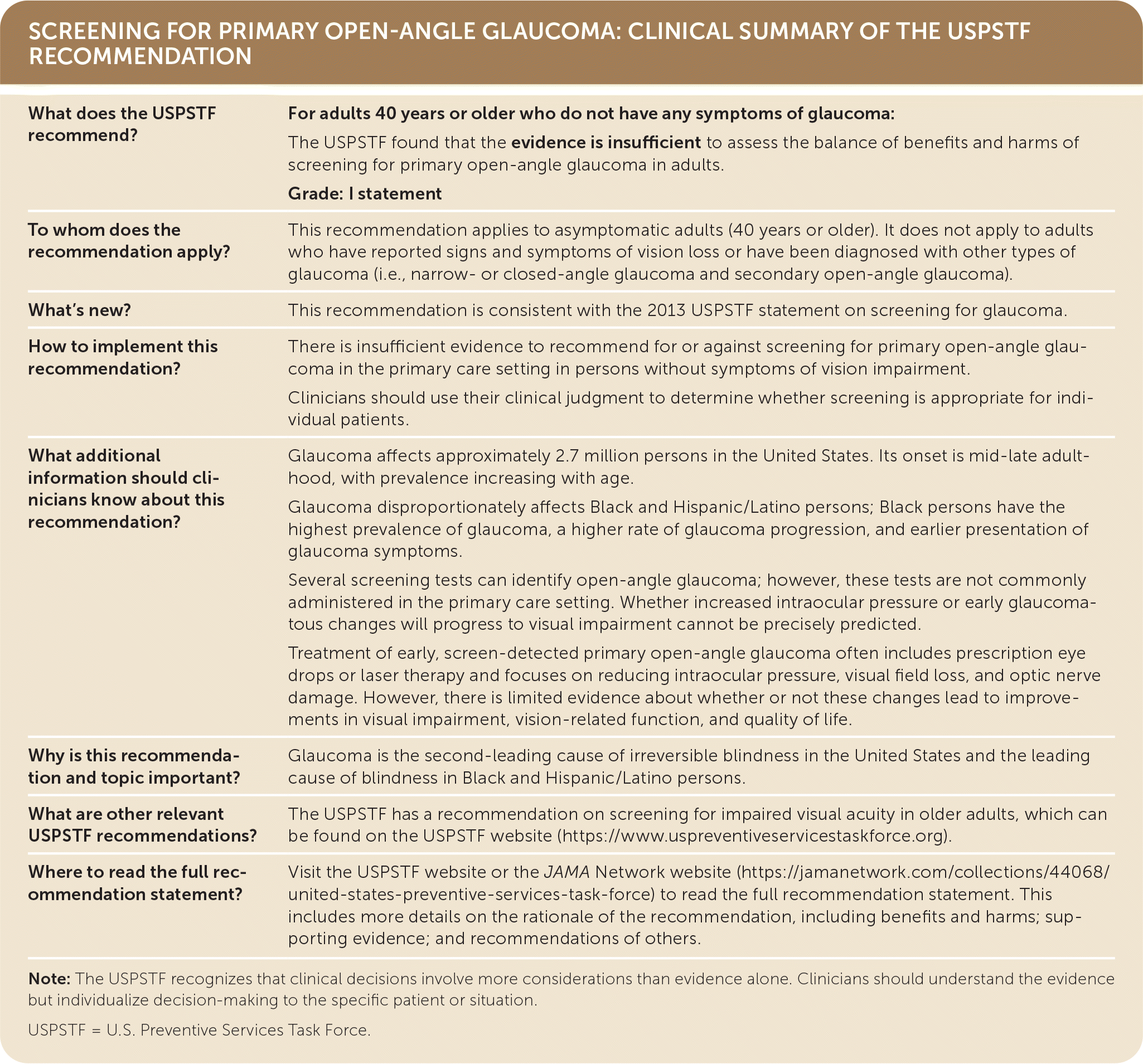
Am Fam Physician. 2022;106(6):online
As published by the USPSTF.

| What does the USPSTF recommend? | For adults 40 years or older who do not have any symptoms of glaucoma: The USPSTF found that the evidence is insufficient to assess the balance of benefits and harms of screening for primary open-angle glaucoma in adults. Grade: I statement |
| To whom does the recommendation apply? | This recommendation applies to asymptomatic adults (40 years or older). It does not apply to adults who have reported signs and symptoms of vision loss or have been diagnosed with other types of glaucoma (i.e., narrow- or closed-angle glaucoma and secondary open-angle glaucoma). |
| What’s new? | This recommendation is consistent with the 2013 USPSTF statement on screening for glaucoma. |
| How to implement this recommendation? | There is insufficient evidence to recommend for or against screening for primary open-angle glaucoma in the primary care setting in persons without symptoms of vision impairment. Clinicians should use their clinical judgment to determine whether screening is appropriate for individual patients. |
| What additional information should clinicians know about this recommendation? | Glaucoma affects approximately 2.7 million persons in the United States. Its onset is mid-late adult-hood, with prevalence increasing with age. Glaucoma disproportionately affects Black and Hispanic/Latino persons; Black persons have the highest prevalence of glaucoma, a higher rate of glaucoma progression, and earlier presentation of glaucoma symptoms. Several screening tests can identify open-angle glaucoma; however, these tests are not commonly administered in the primary care setting. Whether increased intraocular pressure or early glaucomatous changes will progress to visual impairment cannot be precisely predicted. Treatment of early, screen-detected primary open-angle glaucoma often includes prescription eye drops or laser therapy and focuses on reducing intraocular pressure, visual field loss, and optic nerve damage. However, there is limited evidence about whether or not these changes lead to improvements in visual impairment, vision-related function, and quality of life. |
| Why is this recommendation and topic important? | Glaucoma is the second-leading cause of irreversible blindness in the United States and the leading cause of blindness in Black and Hispanic/Latino persons. |
| What are other relevant USPSTF recommendations? | The USPSTF has a recommendation on screening for impaired visual acuity in older adults, which can be found on the USPSTF website (https://www.uspreventiveservicestaskforce.org). |
| Where to read the full recommendation statement? | Visit the USPSTF website or the JAMA Network website (https://jamanetwork.com/collections/44068/united-states-preventive-services-task-force) to read the full recommendation statement. This includes more details on the rationale of the recommendation, including benefits and harms; supporting evidence; and recommendations of others. |
The full recommendation statement is available at https://www.uspreventiveservicestaskforce.org/uspstf/recommendation/primary-open-angle-glaucoma-screening.
The USPSTF recommendations are independent of the U.S. government. They do not represent the views of the Agency for Healthcare Research and Quality, the U.S. Department of Health and Human Services, or the U.S. Public Health Service.
